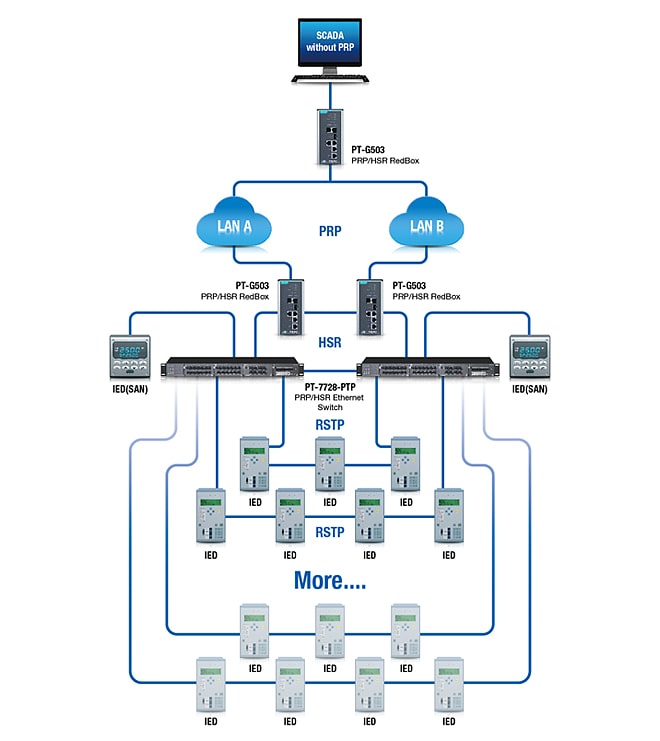
The Key to PRP/HSR Connectivity
New switch brings legacy devices to PRP/HSR networks.
The Moxa PT-7728-PTP is the world’s first modular rackmount switch that integrates multiple redundancy protocols on one device. The multi-protocol interoperability, including PRP/HSR, RSTP Grouping, RSTP, or Turbo Ring and Turbo Chain, facilitates flexible network deployment and integration.
Learn more below.
Hybrid PRP/HSR for Flexible Integration
Integrating Devices on the Device Level
- Integrate multiple SANs into PRP/HSR networks
- Three connection modes:
- PRP
- HSR
- Coupling
Integrating Legacy RSTP Architectures
- Moxa PRP/HSR switches can connect RSTP rings to HSR rings via dual homing with two separate nodes.
Scalable IED Integration
- A network combination of Redboxes, PRP/HSR switches, and embedded modules enables scalable HSR rings
- Enable HSR extensions with an adjustable risk-benefit ratio
- Embedding an EOM-G103 into a SAN node can turn the SAN into PRP/HSR DAN
Multiple PRP Networks Connected to One HSR Ring
- Complete the vertical integration of field devices to the control room
- PRP networks connect protection relays to field devices, such as a GPS masterclock
Multiple HSR Rings Connected to One PRP Network
- Add more HSR rings via PRP
The Need for and Concerns About PRP/HSR Redundancy
In applications where milliseconds matter, networks cannot afford any downtime whatsoever in case of a network failure. While the IEC 62439-3 defines standards for the implementation of zero-time recovery, customers are also concerned about the complexity of a device, its costs, and the increased traffic load on their network.
A New PRP/HSR Switch
Moxa’s PT-7728-PTP PRP/HSR switch is designed to implement zero packet loss and zero-time recovery to achieve the highest network availability in compliance with Parallel Redundancy Protocol (PRP) and High-availability Seamless Redundancy (HSR) protocol, both defined in the IEC 62439-3 standard.
The PT-7728-PTP ensures the highest network availability for mission-critical applications, and it bridges legacy devices to PRP/HSR networks with flexible hybrid connectivity options for both new and retrofit applications.
RSTP Grouping for Legacy Migration
In addition to implementing zero-time failover when a single path fails, the PT-7728-PTP’s RSTP Grouping technology (patent pending) successfully connects a large number of RSTP devices to HSR networks.
Thanks to RSTP Grouping, the PT-7728-PTP can migrate more than a thousand RSTP devices to HSR networks—far more than the maximum of 40 hops allowed in a typical RSTP ring.
The capabilities of a hybrid HSR and RSTP topology are especially advantageous for substations that want to add PRP/HSR segments to their legacy RSTP-based networks to improve network performance and reliability.
Legacy-to-Hybrid Network Deployment
Enabling the Connection of Legacy Devices

Leveraging the interoperability between standard PRP, HSR, and RSTP protocols, the PT-7728-PTP enables many legacy RSTP devices and SANs (single attached nodes) to get connected to PRP/HSR networks, extending their lifetime.
High Network Availability
Through multiple couplings of RSTP and HSR rings, the PT-7728-PTP not only adds the best value to legacy devices and infrastructures, but it also improves network availability as defined in the IEC 61850-3 standard for time-critical applications.
Proven Interoperability
The PT-7728-PTP switch demonstrated its redundancy and interoperability capabilities in the 2015 PRP/HSR Interoperability Test, conducted by UCAIug. The PT-7728-PTP and Moxa’s PT-G503 RedBox were the only DUTs (devices under testing) that provided dual connections between PRP/HSR and RSTP network segments.
